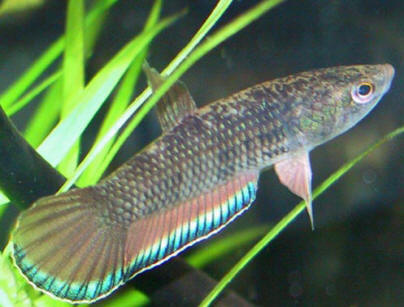|
Betta picta
Valenciennes
1846

Betta picta
Photo by Kei Sasaki (Betta House) [5]
Keeping Betta picta from an Aquarist View
| Housing |
Betta picta can be housed in pairs, species
tanks, and community tanks. Pairs can be housed in a 2.5
gallon tank, groups should be housed in a 10 gallon tank or
larger. Pairs should be given cover such as caves and
plants. In a pair or species situation it is possible that
fry could be discovered in the tanks. For best results
remove a brooding male. |
| Water Conditions |
Not critical, picta is very tolerant of water
chemistry and thrives in almost any type of water as long as it is
clean and well filtered. They should be kept at cool to mid 70s F. |
| Sexing |
Males have a broader head then females and a much
darker stripe on the anal fin. Females may not have a stripe or faint
stripe on the anal fin. Females ovaries might be visible via
spotlighting.
  |
| Reproduction |
Picta is a paternal mouthbrooder and the male
incubates from 9 to 12 days with 10 days being very consistent.
Incubation time can vary with water temperature. Females normally
initiate spawning. |
| Similar Species |
Similar species would be picta complex members
simplex, falx and taeniata. |
| Identification |
Picta males normally do not have a highly pronounced
stripe in the caudal fin where as falx and simplex do. |
Articles on Betta picta
Betta picta: Not Very Beautiful, But Interesting Nonetheless-
Gerald Griffin, 1988 Republish from Flare Magazine
Betta picta (Sumatra)
Yohan Fernando
Betta picta
- Carolyn Hanlon, 2007
Articles on related species
Care and
Breeding of Betta falx Gerald Griffin 2003,
Republish from Flare Magazine
I’ve Got a New Mouthbrooding Betta – Now What? Michael Hellweg. 2003.
Working with
wild Bettas Gerald Griffin. Flare! 2006
More Photos
| Original Citation |
Cuvier, G. and Valenciennes, A. 1846. [37] |
| References |
Baensch, H.A. and R. Riehl, 1985. [24]
Robins, C.R., R.M. Bailey, C.E. Bond, J.R. Brooker, E.A.
Lachner, R.N. Lea and W.B. Scott, 1991. [88]
Schuster, W.H. and R. Djajadiredja, 1952. [95]
Grabda, E. and T. Heese, 1991. [45]
Kottelat, M., A.J. Whitten, S.N. Kartikasari and S.
Wirjoatmodjo, 1993. [58]
Eschmeyer, W.N., Editor, 1998. [40]
Bleeker, P. 1850. [30]
Bleeker, P., 1851. [32]
Tan, H. H. and Kottelat, M. 1998. [101]
Tan, H. H. and M. Kottelat, 1998. [103]
Fernando, Yohan. [43]
Griffin, Gerald. 1988. [117]
Liebetrau, Sue. 1975. [125]
Pinto, Tony. 2002. [138]
|
| Type Locality |
Near Buitenzorg, Java, Indonesia. |
| Holotype |
No Types Known |
| Where Found |
Countries:
|
Indonesia
Malaysia
|
| Known Occurrences: |
Indonesia: Indian Archipelago
Indonesia: Pajakumbu, W.-Sumatra, Indonesien
Indonesia: Südöstlich von Medan Deli, Sumatra, Indonesien |
| Miscellaneous Information |
Max Size:
|
6.0 cm TL; 2 1/2 inches |
| pH range: |
6.5 - 7.5 |
| dH range: |
22.0 |
| Temperature range: |
22 - 24°C |
| Differentiation from similar species: |
"[Writing about the misnomer Betta pictum]…a
small (5 cm - about the size of [B.] smaragdina)
mouthbrooder. The color description is like that of [B.]
brederi [B. pugnax]; however, [B.] pictum is
from high mountain streams in Java, Singapore, and Sumatra, and
can stand cooler temperatures." [125] |
Last modification submitted by Gerald Griffin
01.27.08
 |
 |
 |
 |
Betta picta
photo by Kei Sasaki (Betta House) [5] |
Betta picta brooding
photo by Kei Sasaki (Betta House) [5] |
Betta picta brooding
photo by Kei Sasaki (Betta House) [5] |
Betta picta
photo by Kei Sasaki (Betta House) [5] |
 |
 |
 |
 |
Betta picta
photo by Kei Sasaki (Betta House) [5] |
Betta picta male mouthbrooding
photo by Eric Naus [1] |
Betta picta pair
photo by Eric Naus [1] |
Betta picta female
photo by Eric Naus [1] |
 |
|
|
|
Betta picta juvenile
photo by Eric Naus [1] |
|
|
|
|